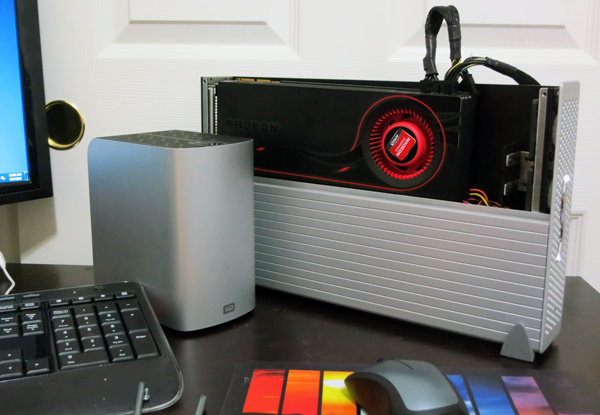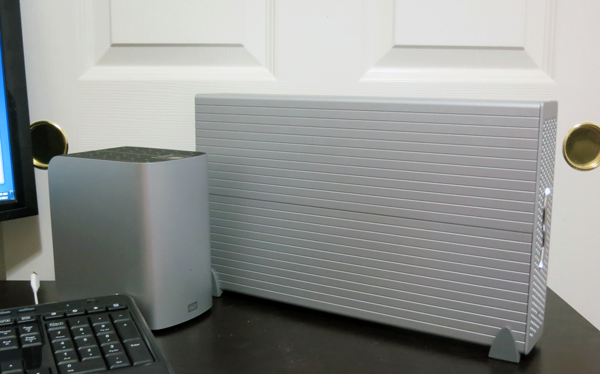Echo Express Pro: Desktop Graphics In A Thunderbolt Chassis
Thunderbolt Paves The Way For Discrete Graphics, Externally
I've been using Sonnet Technologies' Echo Express Pro with a Sandy Bridge-based MacBook Pro and my MSI Z77A-GD80-based desktop PC for more than two weeks. The entire experience is completely plug-and-play. Install the card, the appropriate drivers, and the combination simply works.

The only bummer is that Sonnet Technologies' Echo Express line-up isn't really designed for graphics cards. A lack of auxiliary power connectors limits the number of boards you can use. Mainstream cards that get everything they need from the PCI Express bus are one option. Or, hooking up your own power supply, as we did with our Radeon HD 6970, could work too. Either way, we'd like to see Sonnet incorporate at least one six-pin lead to fully exploit the Pro model's 150 W peak power delivery.
If you do end up using a card with auxiliary power connectors, pay close attention to their orientation. As you can see in the image above, the chassis is designed to exacting specifications just large enough to accommodate full-height PCI Express cards. A top-mounted power connector will force you to use the enclosure with its top popped. Of course, that's wholly a side effect of our desire to see a potent GPU sitting alongside an Ultrabook, driving a demanding AAA title faster than any mobile graphics module could muster. Mission accomplished (even if we had to use a PC power supply to get there).
Of course, professionals planning to use the Echo Express family for storage, networking, or A/V should expect a much more streamlined experience. The two top-end chassis have no trouble closing around standard-sized cards, all of which are more power-friendly than discrete graphics boards. Just bear in mind the card-length limitations of each model. Stepping down to the Echo Express SE constrains you 6.6"-long cards, while the Echo Express takes 7.75"-long expansion products.

Although the $800, $600, and $400 price points might make sense to professionals looking to add heavy-hitting capabilities to mobile systems that normally wouldn't support them, enthusiasts almost certainly won't spend what it'd take to drop a $200 graphics card into an $800 Thunderbolt-based chassis. We'd really like to see something like the Echo Express Pro for the desktop crowd, enabled with graphics-oriented power connectors and a more affordable price tag.
At least you don't have to worry too much about procuring a flagship graphics card, right? Our benchmarks show us that a GeForce GTX 460 is, in many cases, just as fast as the higher-end Radeon HD 6970 as a result of the interface constraints of Thunderbolt. Pinching off that bus means that, at a certain point, it doesn't matter how big of a GPU you attach to the host. The good news is that an old faithful GTX 460 fits perfectly in the $600 Echo Express.
Sonnet Technologies deserves considerable praise for introducing us to the first Thunderbolt-based expansion chassis for PCI Express add-in cards. Almost one year has passed since we first saw MSI's GUS II, but that company still hasn't set a shipping date. There's a three-slot Magma ExpressBox 3T available with a bigger power supply, but it's twin x8 and single x4 slot configuration doesn't handle graphics cards well. Moreover, a nearly $1000 price tag makes the Echo Express look like a comparative bargain at $600.
Get Tom's Hardware's best news and in-depth reviews, straight to your inbox.
We'd love to see a more graphics-oriented external enclosure emerge in time for next year's CES. Until then, there's plenty of potential to use Sonnet Echo Express for high-impact graphics, or any other number of PCI Express-based expansion upgrades aimed at professionals craving serious performance.
Current page: Thunderbolt Paves The Way For Discrete Graphics, Externally
Prev Page External Graphics Performance: Gaming-
amuffin Well, getting a laptop that supports thunderbolt is already pretty expensive. Then, you have to get one of these which ranges from $400-$800. THEN you have to buy a dedicated card....Reply
It's pretty expensive once you add it all up :/ -
yobobjm I like it, but I see limited use for it, especially for those of us who already have large towers, and don't really want another small tower added on to that. That being said, this would make a pretty awesome home dock for a laptop, and good for those tiny desktops that intel, apple, asrock, zotac and many others make (once all of those get thunderbolt).Reply -
acku Prices will go down. Remember that.Reply
Second, it's about the cost you'd have to pay anyways for a desktop (which you need if you want to game since you can't on a vanilla ultrabook), so its more like an alternative solution for those who want a single system setup.
Cheers,
Andrew Ku
Tom's Hardware -
mayankleoboy1 any controller + the surrounding ecosystem that is this expensive cant survive much. Not being a hater, but being a realist.Reply -
acku You don't know that :). USB 3.0 was expensive when it first came out. Look at things now. Wow things have changed. Prices are substantially lower now.Reply -
Vorador2 Needs to be cheaper. That's my only serious gripe.Reply
And well, for this purpose Thunderbolt still needs to be faster to fully take advantage of the external GPU, best around 16 Gb/s since it's the speed of a 16x PCIE 3.0 slot.
Although you could potentially sidestep this issue if you use two linked thunderbolt interfaces, but then there's the problem of synchronizing data transfers (and finding a laptop with two thunderbolt interfaces...if there's any) -
Menigmand If they can make this much cheaper, I would be very interested. I prefer to game on a laptop so I can easily stow it away when I have guests over and need the dining table. An extra box would be ok, as long as it doesn't need an external display.Reply -
assasin32 Well this makes things more interesting, when the price goes down and becomes resonable within probably the next few years it may give us the ability to buy laptops and attach some reasonble GPU's to them so we can play games on them a lot better.Reply
If this was around 8 years ago I would have been all over it and had it for my laptop since I used to use that for gaming.